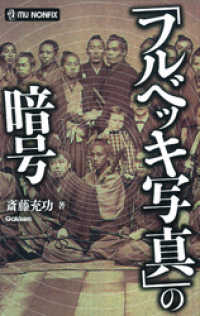- ホーム
- > 洋書
- > 英文書
- > Philosophy
Full Description
Shows how the emerging Chinese empire purposely reconceived but was also constrained by basic spatial units such as the body, the household, the region, and the world.
This book examines the formation of the Chinese empire through its reorganization and reinterpretation of its basic spatial units: the human body, the household, the city, the region, and the world. The central theme of the book is the way all these forms of ordered space were reshaped by the project of unification and how, at the same time, that unification was constrained and limited by the necessary survival of the units on which it was based. Consequently, as Mark Edward Lewis shows, each level of spatial organization could achieve order and meaning only within an encompassing, superior whole: the body within the household, the household within the lineage and state, the city within the region, and the region within the world empire, while each level still contained within itself the smaller units from which it was formed. The unity that was the empire's highest goal avoided collapse back into the original chaos of nondistinction only by preserving within itself the very divisions on the basis of family or region that it claimed to transcend.
Contents
Acknowledgments
Introduction
Units of Spatial Order
The Empire and the Reconstruction of Space
1. The Human Body
Discovery of the Body in the Fourth Century b.c.
The Composite Body
Interfaces of the Body
Conclusion
2. The Household
Households as Political Units
Households as Residential Units
Households as Units of Larger Networks
The Household Divided
Household and Tomb
Conclusion
3. Cities and Capitals
The World of the City-States
Cities of the Warring States and Early Empires
Invention of the Imperial Capital
Conclusion
4. Regions and Customs
The Warring States Philosophical Critique of Custom
Custom and Region
Regions and the Great Families
Regional and Local Cults
Rhapsodies on Regions
Conclusion
5. World and Cosmos
Grids and Magic Squares
The Bright Hall and Ruler-Centered Models
Mirrors, Diviner's Boards, and Other Cosmic Charts
Mountains and World Models
Conclusion
Conclusion
Notes
Works Cited
Index







